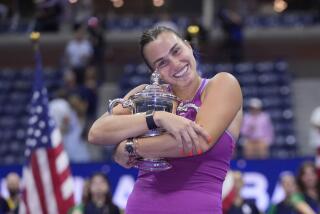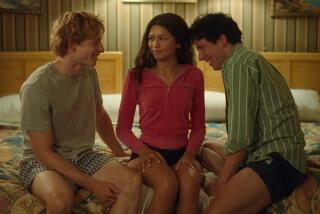Sunken Treasure Retains Its Luster
- Share via
INDIAN WELLS — It is 11 a.m. Sunday at the La Quinta Tennis Club, five miles up the road from where the real tennis in the desert is about to begin, the men’s singles final at the sparkling new $75-million Indian Wells Garden.
The famous sunken court at La Quinta is empty. The plaque on the wall of the adjacent restaurant, overlooking the court and commemorating the accomplishments of longtime desert resident and all-time great player Ellsworth Vines, in whose name the court was designated in a ceremony several years ago, goes unnoticed by hotel guests.
In the tennis pro shop, they are busy selling T-shirts and directing people to the gym and treadmills. “Only hotel guests can play” on the sunken court, they are told, and “only if they request it.”
Few request it. It mostly sits alone, a monument to the days when it was central to big-time tournament tennis in the desert, when its surrounding carefully manicured palm trees and soft grass terraces symbolized a pinnacle of sorts in the game.
*
“It was 1985, and Larry Stefanki was our local guy,” recalls Charlie Pasarell, who has taken tennis in the desert from that sunken court at La Quinta, to a nice 11,500-seat stadium at the Hyatt Grand Champions, to his current 16,100-seat marvel.
“Because he was local, we gave Stefanki a wild card, put him out on our sunken Clubhouse Court for his first round, and he won. So we put him out there again for the second round, and the third. He kept winning.
“We had this bigger center court, right behind the Clubhouse Court, and it seated about 8,000, but it was only some temporary bleachers. Still, that’s where the main matches went, because of the larger seating. Well, as Larry kept going through the tournament, he kept asking to play on the Clubhouse Court. Finally, he got to the semifinals, and we told him he would have to play that one on the big court. But it rained, we had to split the semifinals, and we put him out there again. And he won. Probably was the only semifinal we ever played there.
“Now, afterward, he’s in my office asking if we could play the final on the Clubhouse Court. He knew he couldn’t, but it ended up not mattering. He played David Pate in the final and won in five sets in one of the best finals we have ever had.”
*
The March pro tennis event that has become a staple of this area, and the tennis tours, was held in Tucson in the early 1970s. It was moved to the Palm Springs area, to Mission Hills, in 1976, and called the American Airlines Tennis Games. It was the Volvo Tennis Games in ‘79-’80 and ran into a crisis in ‘80, when they had what became known as the 100-Year Flood in the desert, nonstop rain that happens about once every 100 years. Play could not be held after the quarterfinals.
By then, Pasarell, and his partner-to-be, Ray Moore, both pro players in the twilight of their careers, were getting involved in the running of the event. For a period after the 1980 rain fiasco, the pro tour had decided to take the event to Florida. Eventually, Pasarell kept a tournament sanction for the desert and this area didn’t miss a year.
In 1981, La Quinta was the tournament home, the final matched Jimmy Connors and Ivan Lendl and total prize money was $175,000. Under the sponsor names of Congoleum Classic and Pilot Pen Classic, it grew to a $405,000 purse for the 1986 final won by Joakim Nystrom over Yannick Noah. In those five years, there were numerous memorable moments, many on the sunken Clubhouse Court.
*
“It was when Andre Agassi was about 15 years old,” Pasarell recalls, “and Pancho Gonzalez called and asked if I’d give this up-and-coming kid a wild card.
“So when Agassi played his first match in our Pilot Pen, I went out to see this kid. Looked like he could hit a huge forehand. He won his first round.
“He had to play Mats Wilander next, and Mats was then No. 1 or 2 in the world. He walks into my office to ask about this kid. I said he hits a huge forehand. Just keep it away from his forehand.
“So, because it is Wilander, I put them out on the Clubhouse Court. I go out to watch. Wilander sees me, and he starts hitting everything to the kid’s forehand, just crushing it and the kid. Finally, he looks up at me in the crowd and winks.”
*
Sunday’s men’s singles winner, Alex Corretja, stands in the middle of center court about 2:15 p.m. Around him, 16,100 seats rise in giant sections in an amazing testimonial to Pasarell his vision of the future of tennis here.
“A year ago,” Corretja says in his victory speech, “all there was here was desert.”
He takes his $400,000 check, his share of a purse that has reached nearly $2.5 million, and his Waterford Crystal trophy.
Eventually, after Alex O’Brien and Jared Palmer win another doubles crown and edge closer to No. 1, the last gathering of fans that totaled 186,690 for the 10-day tournament wanders out to the parking lots.
Next year, 200,000 seems a cinch. Pasarell calls this “just a beginning.”
Actually, the real “beginning” was that sunken court at La Quinta, a forgotten shrine now.
More to Read
Go beyond the scoreboard
Get the latest on L.A.'s teams in the daily Sports Report newsletter.
You may occasionally receive promotional content from the Los Angeles Times.











